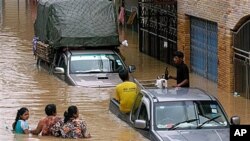Floods late last year devastated thousands of Thai communities and cost hundreds of millions of dollars in infrastructure and economic damage. While the floods were larger than usual, Thailand historically has endured regular flooding. Scientists say the country must develop a long-term plan to manage one of its biggest hazards, and biggest assets - water.
The worst floods in almost 50 years left more than 230 people dead in Thailand late last year, caused $1.7 billion in damage, and soaked tens of thousands of hectares of farmland.
The floods, which began in October, affected half of Thailand’s 76 provinces. The southern provinces well into January suffered from new floods and landslides.
Meteorologists say the floods were aggravated by the La Nina weather phenomenon, which occurs when Pacific Ocean surface temperatures are lower than normal, leading to above average rainfall over land.
But Thailand is no stranger to floods, even when there is no La Nina. As in much of Southeast Asia and southern China, the annual monsoon rains arrive in April or May after the long dry season ends, and they often bring floods.
Danai Thaitukoo, a lecturer in architecture at Bangkok’s Chulalongkorn University, says the regular floods highlight a need for effective long-term water management policies throughout the country.
"We just solve the problem in front of us but we do not prepare for the long-term variation,” Danai said. “It is like we have the solution but we did not actually do it. The country needs to look at the water issue as a national security; so it is not just food security it is water security. But at the top policy level all the ministries are not taking it seriously."
Scientists and community planners here say Thailand’s long dry season also needs to be addressed, because too often, communities run short of water during the dry months.
"We always look at water in the rainy season as an excess, as a waste, as something unwanted and [we need to] get rid of it,” said Anond Snidvongs, a climatologist at Chulalongkorn University. “And in the dry season we complain and then OK, we do not have enough water. You need to change the attitude toward water. Do not look at it as a waste, but as an asset."
Anond says there should be an effort to meet demands for water in the dry season by constructing water retention pools - not full dams - to store water during the rainy season.
The country has had some successes in managing water flows. Major engineering work during the past decade has reduced the risk of floods in Bangkok. The city has built more than 70 kilometers of walls along the Chao Phraya River and a series of flood walls extends out beyond the city.
Last year’s floods prompted the government of Prime Minister Abhisit Vejjajiva to reassess flood mitigation and irrigation systems. The government hopes to centralize water management programs.
"The prime minister is now asking all ministries relating to water management to coordinate their plans, with the center being at the government house [prime minister’s offices],” said government spokesman Panitan Wattanayagorn. “The water management plan in general for agriculture is now coordinated under the new master plan [and] for the first time we have major investment focused on this issue rather than allowing different ministries to manage their own water systems."
Business and farming leaders, as well as water management experts, say effective water management is crucial for Thailand, which is a leading rice exporter.
They say improved water management systems will increase and diversify agricultural output and will improve incomes by using water as an asset rather than as waste.









